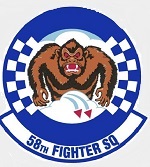Hobby Master HA1934 USAF McDonnell F-4E Phantom II Fighter-Bomber - Capt. Steve Ritchie and RIO Capt. Chuck DeBellevue, "Paula 1", 58th Tactical Fighter Squadron "Gorillas", 432nd Tactical Reconnaissance Wing, Udorn RTAFB, Thailand, 1972 (1:72 Scale)
"My fifth MiG kill was an exact duplicate of a syllabus mission (at Fighter Weapons School), so I had not only flown that as a student, but had taught it probably a dozen times prior to actually doing it in combat."
- Captain Richard "Steve" Richie commenting on his fifth and final aerial victory which occurred on August 28th, 1972
 The McDonnell Douglas F-4 Phantom II is a two-seat, twin-engined, all-weather, long-range supersonic fighter-bomber originally developed for the U.S. Navy by McDonnell Aircraft. Proving highly adaptable, it became a major part of the air wings of the U.S. Navy, Marine Corps, and U.S. Air Force. It was used extensively by all three of these services during the Vietnam War, serving as the principal air superiority fighter for both the Navy and Air Force, as well as being important in the ground-attack and reconnaissance roles by the close of U.S. involvement in the war.
The McDonnell Douglas F-4 Phantom II is a two-seat, twin-engined, all-weather, long-range supersonic fighter-bomber originally developed for the U.S. Navy by McDonnell Aircraft. Proving highly adaptable, it became a major part of the air wings of the U.S. Navy, Marine Corps, and U.S. Air Force. It was used extensively by all three of these services during the Vietnam War, serving as the principal air superiority fighter for both the Navy and Air Force, as well as being important in the ground-attack and reconnaissance roles by the close of U.S. involvement in the war.
First entering service in 1960, the Phantom continued to form a major part of U.S. military air power throughout the 1970s and 1980s, being gradually replaced by more modern aircraft such as the F-15 Eagle and F-16 Fighting Falcon in the U.S. Air Force and the F-14 Tomcat and F/A-18 Hornet in the U.S. Navy. It remained in service in the reconnaissance and Wild Weasel roles in the 1991 Gulf War, finally leaving service in 1996. The Phantom was also operated by the armed forces of 11 other nations. Israeli Phantoms saw extensive combat in several Arab-Israeli conflicts, while Iran used its large fleet of Phantoms in the Iran-Iraq War. Phantoms remain in front line service with seven countries, and in use as an unmanned target in the U.S. Air Force.
Phantom production ran from 1958 to 1981, with a total of 5,195 built. This extensive run makes it the second most-produced Western jet fighter, behind the famous F-86 Sabre at just under 10,000 examples.
The F-4 could carry up to 18,650 pounds (8,480 kg) of weapons on nine external hardpoints, including air-to-air and air-to-ground missiles, and unguided, guided, and nuclear bombs. Since the F-8 Crusader was to be used for close combat, the F-4 was designed, like other interceptors of the day, without an internal cannon. In a dogfight, the RIO or WSO (commonly called "backseater" or "pitter") assisted in spotting opposing fighters, visually as well as on radar. It became the primary fighter-bomber of both the Navy and Air Force by the end of the Vietnam War.
Due to its distinctive appearance and widespread service with United States military and its allies, the F-4 is one of the best-known icons of the Cold War. It served in the Vietnam War and Arab-Israeli conflicts, with American F-4 crews achieving 277 aerial victories in Southeast Asia and completing countless ground attack sorties.
Pictured here is a stunning 1:72 scale diecast replica of a USAF McDonnell F-4E Phantom II fighter-bomber that was attached to the 58th Tactical Fighter Squadron "Gorillas", 432nd Tactical Reconnaissance Wing, then deployed to Udorn RTAFB, Thailand, during 1972.
Sold Out!
Dimensions:
Wingspan: 6-1/4-inches
Length: 10-1/2-inches
Release Date: June 2013
 Historical Account: "For the Defense" - On July 8th, 1972, while flying MIGCAP for chaff bombers, F-4E 67-0362, crewed by Capt. Steve Ritchie and RIO Capt. Chuck DeBellevue, call-sign "Paula 1" received a call from an EC-121 that MiG-21s were returning home and heading their way. Ritchie turned the Phantom and headed straight for them. One MiG-21 flew right past him but based on past experience of where there is on MiG there is a second. Seconds later another MiG-21 raced by so then Ritchie did a 180 and closed on the closest MiG-21 and destroyed it. The first MiG he had encountered was now headed for another Phantom so 67-0362 turned and destroyed their second MiG-21 of the day. This was Ritchies third and fourth MiGs and DeBellevues second and third. Capt. Ritchie would end his tour in Vietnam with five kills while Capt. DeBellevue would score six making him the first RIO/WSO to score 6 kills as well as the only USAF aviator to score this many during the Vietnam War.
Historical Account: "For the Defense" - On July 8th, 1972, while flying MIGCAP for chaff bombers, F-4E 67-0362, crewed by Capt. Steve Ritchie and RIO Capt. Chuck DeBellevue, call-sign "Paula 1" received a call from an EC-121 that MiG-21s were returning home and heading their way. Ritchie turned the Phantom and headed straight for them. One MiG-21 flew right past him but based on past experience of where there is on MiG there is a second. Seconds later another MiG-21 raced by so then Ritchie did a 180 and closed on the closest MiG-21 and destroyed it. The first MiG he had encountered was now headed for another Phantom so 67-0362 turned and destroyed their second MiG-21 of the day. This was Ritchies third and fourth MiGs and DeBellevues second and third. Capt. Ritchie would end his tour in Vietnam with five kills while Capt. DeBellevue would score six making him the first RIO/WSO to score 6 kills as well as the only USAF aviator to score this many during the Vietnam War.


